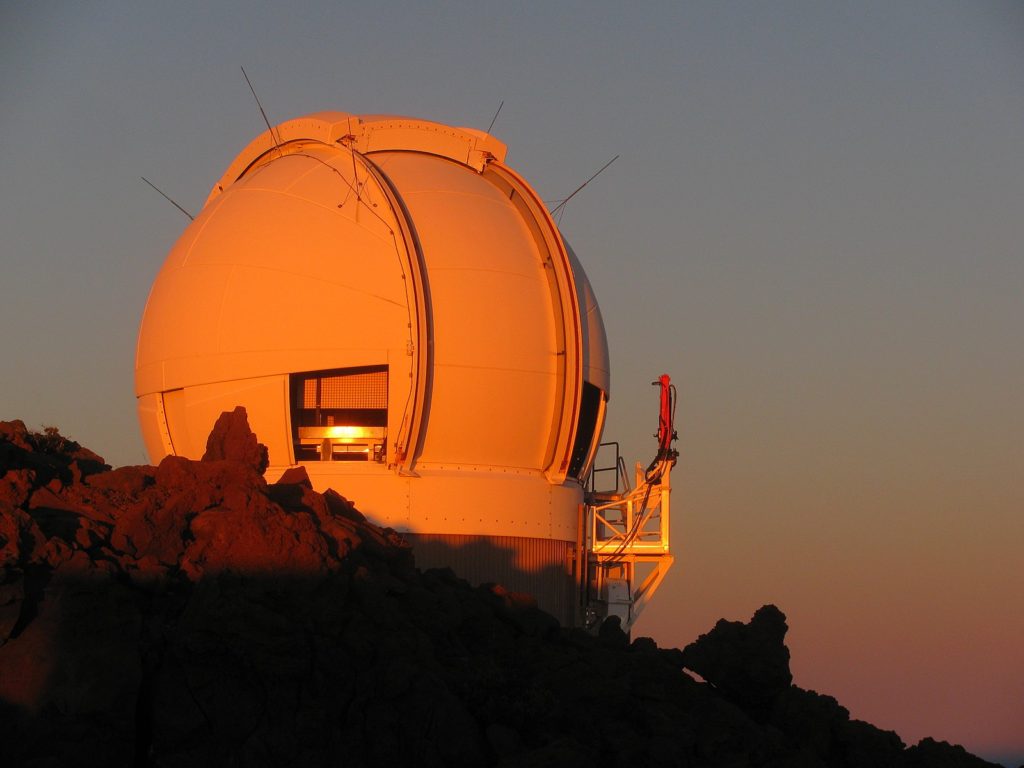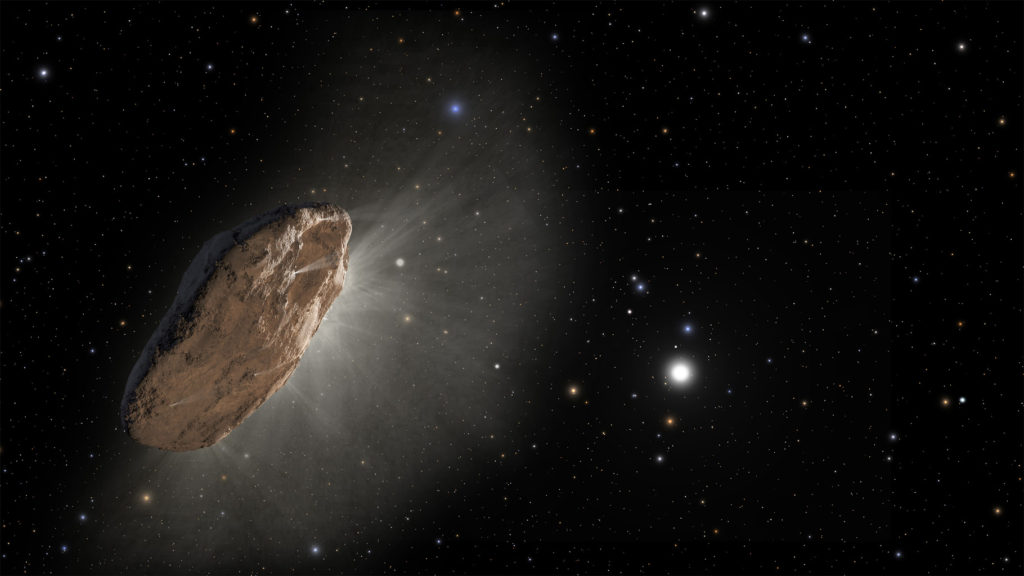On the island of Maui, lassoed by the Pacific Ocean, hikers are not the only ones stargazing. The Pan-STARRS1 telescope scans the sky from the island each night with a primary mission to detect moving celestial objects, especially ones hurtling near Earth. The telescope crouches near the summit of the 10,000-foot Haleakala volcano. Equipped with one of the world’s largest digital cameras, on a good weather night it can image a total of 1000 square degrees of sky. The telescope transfers its images through a high-speed data connection from Maui to the University of Hawaii Oahu campus for analysis. On the night of October 19, 2017 an unknown moving object was detected by Planetary Defense Researcher Robert Weryk. He observed for the first time ever an object of interstellar origin enter our solar system.
Weryk told me recently in an email that he has not seen anything like ‘Oumuamua since that night in October of 2017. “With good weather we can detect well over 10,000 asteroids in a single night, but most are known objects from the main asteroid belt.” He said on average they find two or three Near Earth Objects (asteroids that come close to the Earth) per night.
Upon the initial sighting Paul Chodas, manager at the Center for Near-Earth Object Studies (CNEOS) in Pasadena, California said: “We have been waiting for this day for decades. It’s long been theorized that such objects exist – asteroids or comets moving around between the stars and occasionally passing through our solar system – but this is the first such detection.”
The object’s appearance prompted a new designation scheme by The Minor Planet Center which names objects in space. Initially called A/2017 UI, they later named it 1I/2017 U1, indicating it is the first Interstellar (1I) object. However, the research team at the Haleakala Observatory gave it a more poetic name, ‘Oumuamua, a Hawaiian word meaning “a messenger from afar arriving first.”
Moving rapidly, the object was estimated to be 15 million miles from Earth. By astronomical standards that is close. Its velocity trajectory was not familiar. The object was designated interstellar because its movement was not gravitationally bound to a star. Astrobiologist and lead astronomer at the University of Hawaii Karen Meech, said: “Once it got close enough to the sun, it was moving fast, remaining for very little time in the relatively small region where it is visible to modern-day telescopes.” While moving away from the sun, it didn’t slow down as they would expect from the gravitational pull of the sun, moon, or planets in our solar system.
Apparently, the object dropped into our solar system from above between the sun and the orbit of Mercury. It sped around the sun and moved away from our mighty star in a way that baffled scientists. Existing telescopes could keep it in view for only one week. Fortunately, the weather was fair and the sky clear.
For an Earthly comparison, the sighting may be likened to that of explorer Captain James Cook’s first spotting of the kolea birds in the Pacific islands. On his third sea expedition he saw the birds again in the North Pacific and noted in his journal that the birds may have something to teach him about land navigation. The migratory bird can fly from Alaska to Hawaii in 70 hours nonstop in four days. Their journey to a warmer climate and abundant food is accomplished despite an inability to soar or glide. Despite their feathers not being waterproof causing an incapacity to float. Fossil evidence of the bird flights date back to at least 120,000 years. Outside of Hawaii, kolea are known as Pacific golden plover. Their navigation skills remain a mystery to biologists.
Mysteries still abound over what ‘Oumuamua is, where it came from, its material makeup and its trajectory. Scientists want answers. But their first role is to ask questions.
What is ‘Oumuamua? A comet, an asteroid?
Moving celestial objects tend to be comets or asteroids. But ‘Oumuamua did not show the characteristic coma (tail) of a comet, nor was it spinning as an asteroid would. Harvard astrophysicists Shmuel Bialy and Abraham Loeb posed some maverick ideas in a paper published in the Astrophysical Journal Letters. “Considering an artificial origin, one possibility is that ‘Oumuamua is a LightSail, floating in interstellar space as a debris from an advanced technological equipment.” Loeb is chair of the astronomy department at Harvard. They went further, writing: “The LightSail technology might be abundantly used for transportation of cargo between planets.” And even further: “A more exotic scenario is that ‘Oumuamua may be a fully operational probe sent intentionally to Earth vicinity by an alien civilization.” Addressing criticism from academics and scientists who believed the paper’s authors were sensationalizing the interstellar event, Loeb said he didn’t send out a press release on the paper and that the ideas were based on facts. He wrote an article for Scientific American in which he laid out his facts.
Meech, from the University of Hawaii said in a TED Talk: “It’s likely to be celestial driftwood.” In other words, a rock. Meech seemed to be rebuking Loeb’s artificial origin idea. Like a guest wanting to avoid a controversial dinner conversation she said in a please-pass-the-salt kind of way: “We think it might be a leftover archeological remnant from the birth of another planetary system or possibly an artifact from a supernova explosion. But we can’t prove that it’s not artificial.”
Meech and Loeb may be unlikely dance partners, but they were the first ones on the floor. Other scientists chimed in. Inquiry about ‘Oumuamua heightened rather than faded. Its tumbling movement was chaotic. Its orbit deviated from that shaped by gravitational forces. Its unusual acceleration away from the sun was unexplained. NASA’s Spitzer space telescope did not detect any heat that usually radiates from asteroids and comets.
If we look only at the facts, the kolea birds shouldn’t be making a non-stop 3,000-mile flight every year to Hawaii. But they do. Something more is needed. Where does one look when there is no history, when a first is discovered? To the next questions.
What does ‘Oumuamua look like?
During late October 2017 to early January 2018, tracking data from ground-based telescopes and the Hubble Space Telescope showed it had a spotty surface and was elongated. While there are no close-up images of ‘Oumuamua, what could be observed and measured was brightness. The brightness levels varied greatly. It seemed to be wobbling on its long axis and rotating on its short axis. From this, scientists were able to estimate its size as being less than half a mile long and one tenth as wide, a cigar shape. ‘Oumuamua measured a length five to ten times larger than its width. Such a proportion has never been seen in a natural object in our solar system.
What is ‘Oumuamua made of?
Relying on remote observations Meech described ‘Oumuamua as possibly having a flattened oval shape, reflecting a red color, and made of organic material. Oumuamua’s surface registered at least ten times shinier than a typical comet and unlike any asteroid. No dust or carbon-based molecules were detected around it. It appeared to have the density of an asteroid.
Astrophysicist Wes Fraser in Belfast and his team of researchers further analyzed the brightness measurements. In a research summary published in Nature Astronomy, he wrote: “We now know that beyond its unusual elongated shape, this space cucumber had origins around another star, has had a violent past, and tumbles chaotically because of it.”
‘Oumuamua’s near sun thrust was attributed to outgassing by some scientists. When it got close to the sun its exterior heated up and melted its icy interior releasing gas to its surface. Such gas propelled it away from the sun. In an interview with Der Spiegel, Loeb said that if outgassing had occurred the rotation of ‘Oumuamua should have changed. No such effect was detected. He thinks the thrust was due to solar radiation pressure, which has been demonstrated by the Japanese spacecraft, Ikaros. Its solar sail did exhibit acceleration.
A weak outgassing rate is explained by some scientists for ‘Oumuamua’s lack of an observable comet tail. It couldn’t rid its surface of dust particles and evaporating ice debris, the substances that create a comet’s visual tail.
Where did “Oumuamua come from?
Coryn Bailer-Jones of the Max Planck Institute for Astronomy in Heidelberg, Germany, identified possible home stars for ‘Oumuamua. His team of scientists narrowed the possibilities to four stars. Their findings were based on information about ‘Oumuamua’s comet like behavior and data from the European Space Agency’s Gaia mission. It seems stars that had a close encounter with ‘Oumuamua could have ejected it into our solar system.
If scientists are right, ‘Oumuamua has been traveling for millions of years through interstellar space. Meech reported that ‘Oumuamua may have been in our solar system for over a century. It had been traveling too far from the sun to reflect enough light for existing telescopes to detect.
An attempt by the Breakthrough Listen project to pick up a radio signal from ‘Oumuamua failed. ‘Oumuamua stayed silent. Not even a whisper. Should we or could we send an intentional signal of our own to it? This idea met with a lot of opposition in the 1970’s and has not been intentionally pursued since then. The argument against being proactive in sending signals is that we don’t want to give our position away to aliens who are most likely stronger and smarter than we are. In the same way hikers don’t want to make noise that could attract a bear. Time is a factor too. We would need to wait 200 years for a reply from a signal sent 100 light-years (5.8 trillion miles) away.
In June 2018 NASA released a statement: “The object flew by Earth so fast its speed couldn’t be due to the influence of the Sun’s gravity alone. It won’t circle back around again on an elliptical path. Instead, it will follow the shape of a hyperbola. It will keep on going out of the solar system, and never come back.” It’s expected to reach Neptune in 2022.
Scientist Davide Farnocchia at the CNEOS Jet Propulsion Lab, agreed: “This one is gone forever; we probably know as much about it as we’re ever going to know.”
We’re not even left in its dust, since no dust was detected. Scientists often use their imagination to forage the crest of possibilities. Two years later, Loeb is still being criticized for his reference to aliens. In a Boston Globe article he said: “Let’s put all the possibilities on the table.” What we understand is that we don’t and maybe can’t know everything all at once. Our existing technology cannot catch up with ‘Oumuamua as it leaves our solar system. We are left to wonder with many trails to follow.
Future detections?
Hope is on the horizon. The more sensitive Large Synoptic Survey Telescope (LSST) is scheduled to be operational in Chile in 2022. It is expected to detect many such objects, if they are out there. Might they be intrusive like Asian carp in Midwest rivers or rather like new forest growth after a wildfire? A recent study poses the possibility that interstellar objects like ‘Oumuamua could act as seeds helping accelerate the formation of new planets.
Of ‘Oumuamua’s singular status Weryk said, “It is still very much a unique object. We would like to find more of course. We are always looking at new detections to see if they are consistent with being from outside the solar system.”
If no such objects are found ‘Oumuamua’s unique status may be admired as the kolea birds are in Hawaiian culture through songs, stories and hula. Or commercialized, as a brewery in Canada has done with its “interstellar seasonal” beer called ‘Oumuamua Milk Stout.
When readying for their departure, kolea birds gather in flocks for days and then suddenly take off, rising up in the sky and out towards the sea disappearing from eyesight. No one knows what stimulates their take-offs. Some view the bird as a protective spirit. It is unlikely many people view Pan-STARRS1 and astronomers as protectors. Still, the scopes scan the sky each night giving us a peek at the promise of discovery even when it’s mixed with mystery.







